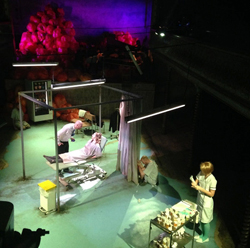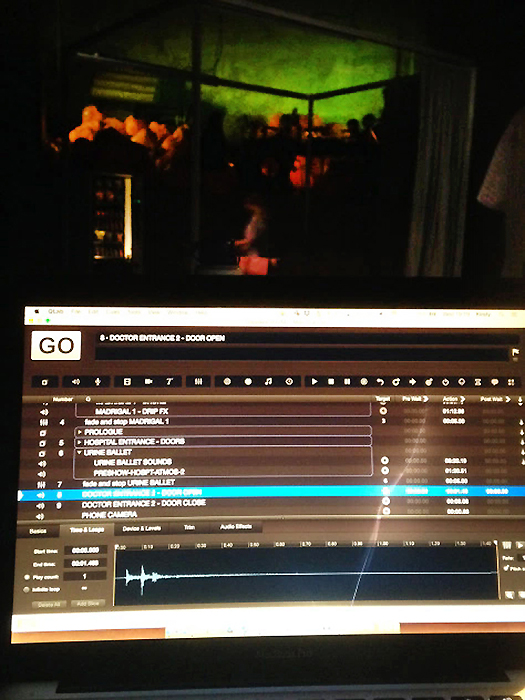
Levels & Challenges
At the first set of tech and dress rehearsals (read on for why there was more than one set), I met my first challenge: to make my layered sound design work sonically with the baroque music.
Levels that I had set painstakingly in the Stage & Piano tech were suddenly overbearing in the Stage & Piano dress rehearsal. And while I altered them, I had to bear in mind that we were setting the levels to work with one harpsichord and the six singers – but this was not the full ensemble. Would they work when we had two harpsichords and another four musicians, plus the singers?
Something that is specific to opera that lighting design colleagues had warned me about is the double tech and dress rehearsal sessions. An opera will have tech and dress rehearsal sessions specifically for the director to work on the acting direction with the singers, accompanied by piano (or in our case, harpsichord) only, called Stage & Piano rehearsals.
It will also have different tech and dress rehearsal sessions for the musical director to work with the full orchestra/ensemble and singers: Stage & Orchestra rehearsals. During these sessions, the technical teams are not allowed to stop any of the proceedings to go over any technical issues.
I had to apply any changes to levels noted in the Stage & Piano dress rehearsal on the fly during the Stage & Orchestra sessions, often without hearing the result. I was most concerned about how this would affect the Prologue and Epilogue, which were pre-recorded speeches (in English) set to the sounds of a contemporary British parliament (House of Commons) sitting.
Both of these speeches, and the accompanying parliamentary sound effects, were instrumental in establishing the context of the opera and aligning themes of the 17th century libretto with the current political climate (and thus the modern setting). They had to be heard clearly above the music, without drowning it out.
As I was urged by some of the production team to make the jeers louder, I had to consider carefully the impact on the music and consider which was more important for the audience to hear.
By this time, some of my levels on QLab (multimedia playback cue-based software designed for theatre) had crept lower and lower, and issues with gain structure became apparent. Having set the levels on the O2R too high, I now had a noticeable amount of hiss coming through the four surround loudspeakers.
Back I went to adjust levels painstakingly on the desk and accordingly, all the levels in QLab. By the start of the Stage & Orchestra dress rehearsal, I was taking my best guess, trusting to my work so far and reminding myself that I could always fix things in previews.
I felt I spent most of my time on “l’Ospedale” filling in spaces with sound, then paring back until it was just present enough to give a scene weight or context. I imagine with the kind of opera that involves grandeur or significant visual or aural impact, the sound design might have a more central role.
In this case, considering the subtlety of the music, allowing the sound design to shine through would have reduced the impact of the performance. It was enough for me that the modern soundscape added to a baroque opera fitted so naturally as to be unnoticeable.
Kirsty Gillmore (www.soundswilde.com) is a sound designer, engineer and voice artist based in the UK. Read more from her at SoundGirls.org.

